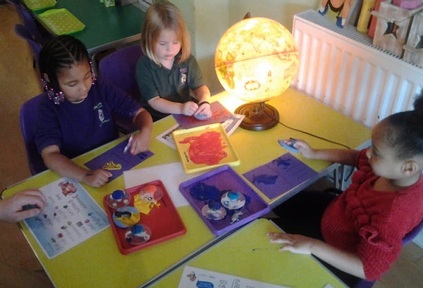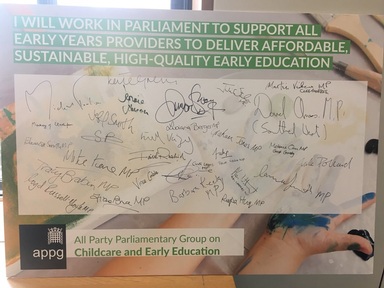Interactive books could 'hinder' children from learning new words
Books with interactive lift-the-flap and pop-up features could prevent young children from learning words, a new study has revealed.

Picture books often include 3D features which are thought to encourage engagement and keep young children interested, but researchers suggest they can ‘often’ be treated as toys rather than a tool for learning.
Dr Jeanne Shinskey, senior lecturer at Royal Holloway University of London, who presented the findings at the British Psychological Society’s annual conference, said: "Many educational picture books for toddlers often feature manipulatives like flaps or textures to encourage interaction, but do these actually help toddlers to learn new words?
"We wanted to test how a commercially-available book with or without flaps affected a two-year-olds’ learning of a new word for an unfamiliar object."
The study split 31 toddlers aged 25 months into two groups. Each group were asked to look through a book with a researcher that contained nine food objects. One book had lift-the-flaps and the other had these sealed.
The toddlers looked through the book with a researcher who labelled each target six times, using Latin for the starfruit (carambola). Of the nine food objects viewed, only starfruit was unfamiliar to all toddlers, as confirmed by their parents.
Researchers tested the toddlers to see if they would recognise the slice of starfruit by name (carambola) when shown both photos and realistic replicas. They were also shown other fruits that were similar in colour and size and whose names were also not very likely to be known at this age, such as a slice of lime and slice of kiwi.
Researchers found that the young children who looked at the book without flaps were significantly more likely to correctly identify the starfruit slice. Nearly 70 per cent of children who looked at the book without flaps correctly remembered the starfruit compared to just 30 per cent of those who were given books with flaps.
'A tool for learning'
Dr Shinskey added: "Books with these sort of features are very popular with parents who hope the interactive feature will aid learning and enjoyment of reading. However, if parents want their children to learn factual information about the world from books, it doesn’t appear to help them if books are more toy-like with 3D features. This seems to enhance their tendency to treat books as just another type of physical toy, rather than a tool for learning.
"As the findings suggest, young children can find these features in a book distracting. We would recommend having a range of books available so children learn to love reading as well as learning more about the world around them."
However, Sue Asquith, early years adviser at National Day Nurseries Association (NDNA) said: "It doesn’t matter if a child sees a book as more of a toy, the learning still happens. A key to young children getting the most out of an interactive book is an older child or adult reading it with them, talking about what they see. Lifting the flaps, for example, supports physical development and also helps children to understand how to handle books. Discussing the content of the book also helps their communication and language."
Naima Browne, quality improvement manager at the Pre-school Learning Alliance, believes sharing books with babies and children is about "more than just learning to identify and name objects, it should also involve fun and playfulness."
She said: "Lift-the-Flap books can form an important part of a child’s early literacy experience as they encourage babies and children to play an active role in the book-sharing moment while helping to develop early literacy skills, for example page turning and following a narrative.
"Lift –the-Flap books, much like peek-a-boo games, encourage social and vocal interactions. They help babies understand about turn-taking, which is an essential element of conversation, and may also play a role in helping a baby develop concepts such as object permanence.
"Sharing interactive books may not be the most effective way of helping very young children learn new nouns, but they do support children’s understanding and use of a whole host of other words and language structures, such as prepositions, questions and responses. The books also provide a fun, supportive and meaningful framework for children who are learning English as an additional language."
'Reading opens doorways to explore new worlds'
Despite extensive research highlighting the importance of reading with children from a young age, many parents struggle to find the time to share reading activities with their children due to work demands and social media distractions.
A survey from Reading Is Fundamental (RIF), conducted by Harris Interactive, found that only one in three parents read bedtime stories with their children every night, whilst half of parents said their children spend more time with TV or video games than with books.
Professor Peter Fonagy, head of the research department of clinical, educational and health psychology at University College of London (UCL), and chief executive of the Anna Freud National Centre for Children and Families, previously said: "A strong, lasting bond between families and children is founded on shared interests, excitement, and wonder - all of which can be achieved by reading for pleasure, which opens doorways to safely explore new worlds and concepts that fire their imaginations.
"Children have a multitude of developmental needs that can all be served simultaneously by reading together with parents or carers they love and trust. The long-term cognitive and emotional benefits are clear – reading together promotes optimal interpersonal, developmental and educational functioning in later life."
Latest News Analysis
 06-Aug-19
Nursery boss says 'cultural capital has always been important, it shouldn't be new'
06-Aug-19
Nursery boss says 'cultural capital has always been important, it shouldn't be new'
 25-Jul-19
Gavin Williamson appointed education minister
25-Jul-19
Gavin Williamson appointed education minister
 17-Jul-19
Flexible Working Bill for all jobs gets MPs approval - delighting parents, disabled and carers
17-Jul-19
Flexible Working Bill for all jobs gets MPs approval - delighting parents, disabled and carers
 03-Jul-19
MPs blame government policies for nursery closures in deprived areas
03-Jul-19
MPs blame government policies for nursery closures in deprived areas
 14-May-19
Number of schools wanting to pilot Reception Baseline Assessments 'embarrassingly low'
14-May-19
Number of schools wanting to pilot Reception Baseline Assessments 'embarrassingly low'